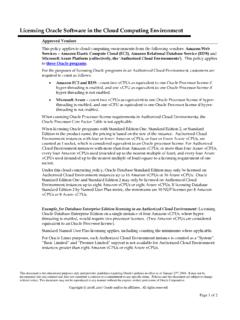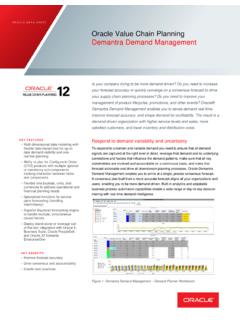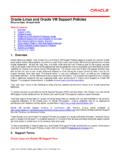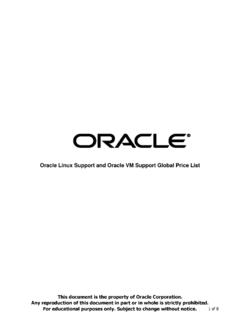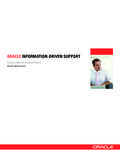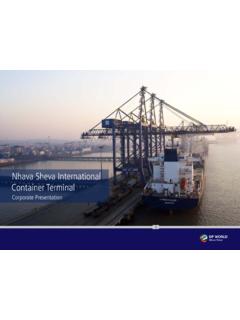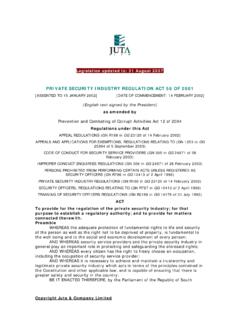Transcription of Oracle Database 19c
1 Oracle Database 19c Introduction and Overview WHITE PAPER / FEBRUARY 4, 2019. PURPOSE STATEMENT. This document provides an overview of features and enhancements available with Oracle Database 19c. It is intended solely to help you assess the business benefits of upgrading to Oracle Database 19c and to plan your projects. DISCLAIMER. This document in any form, software or printed matter, contains proprietary information that is the exclusive property of Oracle . Your access to and use of this confidential material is subject to the terms and conditions of your Oracle software license and service agreement, which has been executed and with which you agree to comply. This document and information contained herein may not be disclosed, copied, reproduced or distributed to anyone outside Oracle without prior written consent of Oracle .
2 This document is not part of your license agreement nor can it be incorporated into any contractual agreement with Oracle or its subsidiaries or affiliates. This document is for informational purposes only and is intended solely to assist you in planning for the implementation and upgrade of the product features described. It is not a commitment to deliver any material, code, or functionality, and should not be relied upon in making purchasing decisions. The development, release, and timing of any features or functionality described in this document remains at the sole discretion of Oracle . Due to the nature of the product architecture, it may not be possible to safely include all features described in this document without risking significant destabilization of the code. 2 WHITE PAPER / Oracle Database 19c TABLE OF CONTENTS.
3 Purpose Statement .. 2. Disclaimer .. 2. Table of 3. Introduction .. 4. Journey to Autonomous Database Cloud .. 5. Multitenant Architecture .. 6. Performance .. 7. High 8. Security .. 11. Data Warehousing and Big Data .. 13. Application Development .. 15. Conclusion .. 17. 3 WHITE PAPER / Oracle Database 19c INTRODUCTION. Oracle Database 19c is the final, and therefore 'long term support' release of the Oracle Database 12c family of products (which includes Oracle Database 18c). 'Long term support' means that Oracle Database 19c comes with 4 years of premium support and a minimum of 3 years extended support. Oracle Database 19c builds upon the innovations of previous releases such as Multitenant, In-Memory, JSON support, Sharding and many other features that enable Oracle 's Autonomous Database Cloud Services.
4 This latest release of the world's most popular Database also introduces new functionality, providing customers with a multi-model enterprise-class Database for all their typical use cases, including: Operational Database use cases such as; traditional transactions, real-time analytics, JSON. document stores and Internet of Things (IoT) applications Analytical Database use cases such as; traditional and real-time data warehouses and data marts, big data lakes and graph analytics This white paper discusses some of the critical capabilities of Oracle Database 19c that can help customers deliver the best performance, scalability, reliability and security for all their operational and analytical workloads, whether for deployment on-premises, in-cloud or in hybrid configurations. 4 WHITE PAPER / Oracle Database 19c JOURNEY TO AUTONOMOUS Database CLOUD.
5 Over successive Database releases, Oracle has introduced innovative automated features that have helped administrators deliver a superior level of service to their end users. These innovations include: Cost-based Optimization Automatic SQL query optimization, automatic statistics gathering, automatic query rewrite automatic SQL Plan management and automatic SQL tuning. Performance Tuning and Diagnostics Automatic memory and resource management, automatic index and materialized view advisors, Automatic Database Diagnostic Monitor, Automatic Database Workload capture & replay and Automatic Workload Repository. Data Optimization Automatic undo management, automatic segment space management, Automatic Storage Management, Automatic Data Optimization and automatic columnar cache. Cloud-Scale Operation. Automatic standby management (broker), Diagnostic Framework, Multitenant Architecture, automatic Database clone refresh and machine learning in Cluster Health Advisor.
6 In March 2018, Oracle introduced the Autonomous Data Warehouse (ADW) cloud service, and this was followed in August 2018 with the introduction of the Autonomous Transaction Processing (ATP). cloud service. By utilizing automated Database functionality with machine-learning techniques, these Autonomous Database Cloud services can provide a level of performance and reliability that manually managed databases struggle to deliver. The Oracle Autonomous Database is specifically designed to provide customers with a higher level of service at lower cost by automating routine administrative tasks and eliminating human error through: Self-Driving. With easy to define workloads and policies, automation then makes them happen. Self-Securing. With automated protection from both external attacks and internal users.
7 Self-Repairing. With automated protection from all downtime. The Oracle Autonomous Database is built on top of the world's most widely proven enterprise-class Database : Oracle Database , it runs on the world's best Database platform: Oracle Exadata, and available as pay-as-you-go services on Oracle Cloud and Exadata Cloud at Customer (for public cloud and private cloud deployment respectively). In addition, machine learning for performance diagnostics and recovery optimizations are built into each layer of the deployment stack. Figure 1. Oracle Autonomous Database Machine Learning 5 WHITE PAPER / Oracle Database 19c MULTITENANT ARCHITECTURE. Designed for the cloud (public or private ), Oracle 's multitenant Database offers a unique architecture that simplifies consolidation and delivers the high density of schema-based consolidation, but without requiring changes to existing applications.
8 In this architecture, a single multitenant container Database (CDB) can host many pluggable' databases (PDBs). Each Database consolidated or plugged in' to a multitenant container looks and feels to applications the same as for pre-multitenant Oracle databases. By consolidating multiple databases into a multitenant container , many pluggable databases share the container memory and processor resources, thereby enabling a greater level of Database consolidation density. In addition, all PDBs in a CDB are all effectively managed as one for Database backup, patching, upgrading and standby operations. Oracle 's multitenant Database also enables greater administrative agility with rapid Database provisioning an online operations such as: PDB Hot Clone enables fast instantiation of PDBs without having to take users offline.
9 PDB Refresh enables cloned PDBs to be regularly updated with latest data. PDB Relocate enables PDBs to be relocated between CDBs with near zero downtime. In addition, the Application container capabilities of Oracle 's multitenant Database allow an application, formerly architected for standalone deployment on-premises, to be converted to an instant Software-as-a-Service (SaaS) architecture, with no code changes. The application is simply installed, unchanged, into an Application Root, and tenant PDBs ( for separate customers) can share the application code while retaining secure isolation of tenant data. Application upgrades need only be applied to the single Application Root master and tenant PDBs simply synchronize with the upgraded master. Oracle 's multitenant Database has been widely adopted by ISVs and customers alike and deployed both on-premises and in the Cloud.
10 Indeed, many Oracle Cloud Database Services including the Autonomous Database Cloud rely on multitenant for tenant isolation, agility and scalability. Oracle Database 18c added a number of enhancements to multitenant functionality including: Faster Deployment of Upgrades, Updates and Revisions. A new infrastructure further reduces the execution time of Database upgrades, updates and revisions. Transportable Backups support the use of backups performed on a PDB prior to it being unplugged and plugged into a new container . This facilitates agile relocation of PDBs between CDBs, perhaps for load balancing or migration between on-premises and cloud, without requiring backups to be taken immediately before, and after, relocation of each PDB. Snapshot Carousel enables customers to define regular snapshots of PDBs that can then be used for a full point in time recovery or to a specific point in time clone.
